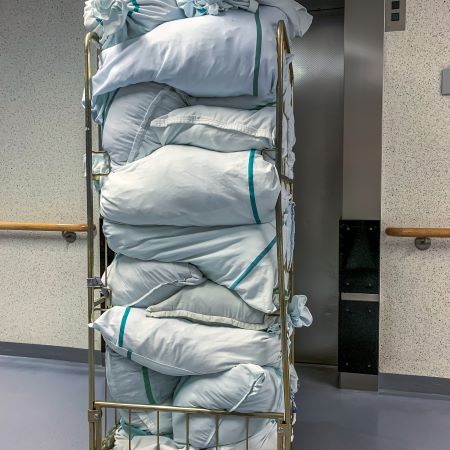How often do we go to the linen closet and say to ourselves, “is this linen safe to put on my patient’s bed?” As a nurse for over 40 years, I do not think that I have ever asked myself that question. I was happy that the linen was there and that I could use it and move onto my next task. Well, the truth is, maybe the linen we are using is not up to the infection control standards we expect.
In a study published in 2019, 15 transplant and cancer hospitals revealed that on visual inspection healthcare linens and laundry carts were unclean upon arrival with 33% (5/15) and 20% (3/15) of hospitals, respectively, with evidence of hair, lint, insects, or other soilage. Healthcare Linens were contaminated with Mucorales in 47% of the hospitals upon arrival. Visibly soiled healthcare linens or carts and the temperature and humidity in the vicinity of a laundry were significantly associated with Mucorales-contaminated linens. (Mucormycosis is a life-threatening infection by fungi of the order Mucorales, which is associated with mortality rates that exceed 50%).
Unfortunately, the United States does not require microbiology testing on hospital linens. However, some third- party certification programs for healthcare laundries do require it. Challenge yourself to learn about your laundry provider. Visit the laundry service facility before signing a contract to see what standards they apply to their services. Conduct periodic spot checks, require a copy of their report from their local health department inspection. Say to yourself, “Would I sleep on this linen” and “Is this what my organization expects from this provider”?
Likewise, if you are cleaning your linen in-house, periodically visit the Laundry Department and perform an infection control tracer to give yourself peace of mind knowing that the linen is being handled properly. The Joint Commission expects organizations to develop their linen cleaning, storage, and management requirements in accordance with evidence-based sources such as the CDC, the National Association of Institutional Linen Management and/or the local or state authority having jurisdiction.
Here are some performance expectations to look for:
• Personnel
o Appropriate attire – Are staff wearing apparel that appears clean and suitable?
o Appropriate shoes – Are staff wearing closed toe, safety sole design?
o Observe for good personal hygiene including clean, trimmed fingernails.
o Is hair completely covered?
o Do staff wear rubber gloves when handling/loading dirty linen?
o Do they distinguish between isolation and regular linen?
o Do staff wear disposable gloves when managing potentially infectious linens? Do they remove those gloves once the task is completed?
o Are staff oriented to infection control policies and attend department/facility-wide infection control in- services?
o Is there a staff screening process for infectious diseases prior to hire?
o Are injuries/suspected infections reported immediately?
o Are staff knowledgeable on how to handle cleaning solutions that may have potential dangers/toxicities? If they require mixing or measuring, are staff performing this function properly? Do they check expiration dates on these products and follow the manufacturer’s instructions for use?
• Washing/Folding/Cleaning/Storage
o Is correct water temperature being used to wash linen?
o Is correct dryer temperature being used?
o Are temperature and humidity being monitored in the department?
o Do staff know how to determine whether the linen is dry prior to folding and storing?
o Is all linen covered when being transported and when stored in the department or nursing unit?
o Is dirty linen physically separated from clean linen?
o Is dirty linen always covered?
o Is Isolation linen transported per organizational policy?
o Are folding surfaces clean and wiped down with a germicidal solution?
o Are logs maintained related to daily cleaning of equipment?
o Is preventative maintenance performed per the Instructions for Use (IFU) on all equipment?
o Are all supplies and solutions used approved by the Infection Control Committee?
o Is staff reporting equipment/supply issues immediately per policy?
If your organization is unsure whether your linen management processes are compliant with the guidelines mentioned above, conducting a gap analysis/risk assessment is a helpful way of identifying potential associated risks and evaluating various options. This proactive activity examines a process in detail including sequencing of events, actual and potential risks, and failure or points of vulnerability that prioritizes, through a logical process, areas for improvement based on the actual or potential impact (that is, criticality) of care, treatment, or services provided. (TJC FAQ)
In summary, by visiting your linen vendor prior to signing a contract and making sure that your staff are reporting any issues with linens to you, you can prevent issues from getting worse. Even though linen seems like a “no brainer” when it comes to its use you only need one microorganism to cause a hospital wide infection control nightmare. In-house Laundry Departments are not without their issues. By doing tracers monthly you will ensure that all linen handled by your in-house staff is done properly ensuring the safety of all those that encounter it.
So, does your organization pass the inspection?
REFERENCES
• How Clean Is the Linen at My Hospital? The Mucorales on Unclean Linen Discovery Study of Large United States Transplant and Cancer Centers, Alexander J. Sundermann, et al, Clinical Infectious Disease, March 2019.
• Does The Joint Commission have specific requirements that address linen management, such as covering, storage and transport? Joint Commission FAQ May 2021
• CDC Guidelines, www.cdc.gov


